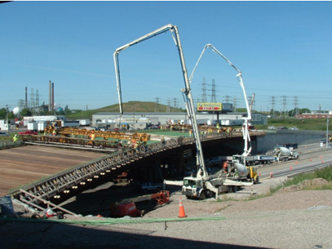June 13, 2024
Innovation of the Month: Enhancing Performance with Internally Cured Concrete
Enhancing Performance with Internally Cured Concrete (EPIC²) increases resistance to early cracking and allows production of concretes that may last more than 75 years. This innovation builds upon extensive studies over the last 30 years that show internal curing addresses the root cause of shrinkage cracking. Internally cured concrete (ICC) has extra water in the concrete mix that becomes available as the free water in the mix is used up during curing. ICC accomplishes this by including materials in the mix that initially absorb water but then release it during the concrete hydration process.
The New York State Department of Transportation (NYSDOT) fully institutionalized the use of ICC in 2017 by requiring it on all new bridge decks for multi-span bridges. In 2024, they updated their specification to extend ICC for use in all bridge decks.
 Interstate 190 / Interstate 290 Interchange project (Credit: American Concrete Institute- Streeter, Wolfe, and Vaughn)
Interstate 190 / Interstate 290 Interchange project (Credit: American Concrete Institute- Streeter, Wolfe, and Vaughn)
NYSDOT’s initial pilot for this technology included 17 projects that showed an overall two-thirds reduction in cracking. One of these projects was the Interstate 190/Interstate 290 interchange in Tonawanda, NY. These two bridges used ICC to help benchmark the material’s properties and collect field data on its viability in bridge decks.
The ICC was placed in the same manner as traditional concrete and pumpability and finishability were both comparable to traditional concrete. The project demonstrated that ICC could be implemented with minimal changes to construction practices while providing durability improvements to the bridge deck.
After one year, inspections found no cracking and the estimated service life of these bridges to be 87 years.
To learn more about NYSDOT’s standard specifications for materials, visit their specifications website or view NYSDOT's new materials procedure.
To learn more about EPIC², please contact Tim Barrett, FHWA Turner-Fairbank Highway Research Center, or Mike Praul, FHWA Office of Infrastructure. Additionally, subscribe to EPIC² email updates to stay informed.
Drones Are Replaceable, You Are Not!
Per the Bureau of Labor and Statistics, in 2022 there were over 1,000 fatal work injuries, by private industry, in the construction industry and more than another 1,000 in the transportation and warehousing industry. The Texas Department of Transportation (TxDOT) is committed to the safety of their approximately 13,000 employees and industry partners and is using unmanned aerial systems (UAS) to make them safer.
Elimination of a hazard is the most effective control in promoting the safety of workers, per National Institute for Occupational Safety and Health (NIOSH) Hierarchy of Controls. For TxDOT, UAS are physically removing people from hazardous situations and making highway workers safer. TxDOT uses UAS for data collection, infrastructure inspection, mapping, and modeling. The UAS typically caries a high-resolution imagers and other data collection sensors.
TxDOT uses UAS to assist in many different aspects of transportation, including bridge inspections, survey (LIDAR and Photogrammetry), natural disasters, and high mast inspections.
Additionally, TxDOT is using UAS to create 3D digital models of transportation facilities, with enhanced data characteristics. One of TxDOT’s goals is to integrate Business Information Modeling (BIM) practices into daily work and use the resulting digital twins to increase safety and efficiency.
One of TxDOT’s first tests with this process was with a widening project. TxDOT converted 2D CAD models to 3D models and integrated multiple data sets into a single experience using ArcGIS. This meant 3D CAD models, UAS captured 3D reality models, terrestrial LIDAR point clouds and aerial imagery could all be used simultaneously. The ultimate goal is to visualize a change and what it will look like before the work is done, then do updates as construction progresses to insure reality matches design intent.
To learn more about TxDOT advancement in UAS for safety and its support toward a digital twin, please contact Sergio Roman, TxDOT UAS Coordinator or Travis Scruggs, TxDOT GIS Analyst. To learn more about FHWA support in the advancement of UAS or digital twin, please contact Bryan Cawley, FHWA.
Funding available for Advanced Digital Construction Management Systems (ADCMS)
On May 30th, 2024, FHWA announced the availability of up to $17 million each for FY2024, FY2025 and FY2026 ADCMS grants.
The ADCMS Program was created in Section 13006 of the Bipartisan Infrastructure Law to promote, implement, deploy, demonstrate, showcase, support, and document the application of ADCMS, practices, performance, and benefits. FHWA will award up to $17 million in ADCMS Program funding for Fiscal Year (FY) 2024 and up to $17 million each for FYs 2025, and 2026 in future announcements. The actual amount available to be awarded will be subject to the availability of funds. Applications for FY 2024 funds must be received by July 30, 2024, at 11:59 p.m., EDT.
Please note that applicants for this grant are limited to State DOTs, the District of Columbia, and the Commonwealth of Puerto Rico. We are encouraging the State DOTs to partner with LPAs and private entities, but will want the State DOT as the recipient with funding allocated through FMIS.
More information on this NOFO and the ADCMS Program can be found at: https://www.fhwa.dot.gov/construction/ADCMS/.
Stay Up to Date on the EDC Innovations That Interest You Most

EDC teams are always on the move! If you blink, you could miss out on important webinars, case studies, tools, videos, and more. To never miss information for the EDC innovations that interest you most, visit the subscription page and select the topics you’d like to receive updates on directly from the teams that coordinate them.
Recent bulletins:
Innovation Exchange 6/6/24
Local Aid Support 6/5/24
Sustainable Pavements 6/4/24
Advanced Digital Construction Mgmt Systems Funding Announcement 5/30/24
Nighttime Visibility for Safety 5/30/24
Rethinking DBE for Design Build 5/29/24
Upcoming Events
Lighting Design for an Urban Street Environment
June 20, 2024, 1:00-3:00 ET Register
About EDC
Every Day Counts, a State-based initiative of the Federal Highway Administration's Office of Innovation and Workforce Solutions, works with State, local, and privatesector partners to encourage the adoption of proven and underutilized technologies to deliver transportation projects more efficiently, enhance safety forall users, support a sustainable and resilient infrastructure, and incorporate equity inproject planning and delivery.
EDC News is a weekly publication highlighting successful EDC innovation deployments across the country.
EDC News is published weekly by the FHWA Center for Accelerating Innovation.
Disclaimer: The U.S. Government does not endorse products or manufacturers. Trademarks or manufacturers’ names appear in this document only because they are considered essential to the objective of the document. They are included for informational purposes only and are not intended to reflect a preference, approval, or endorsement of any one product or entity.
Except for the statutes and regulations cited, the contents of this document do not have the force and effect of law and are not meant to bind the States or the public in any way. This document is intended only to provide information regarding existing requirements under the law or agency policies.
Recommended Citation:
U.S Department of Transportation, Federal Highway Administration
EDC News; June 13, 2024
Washington, DC


